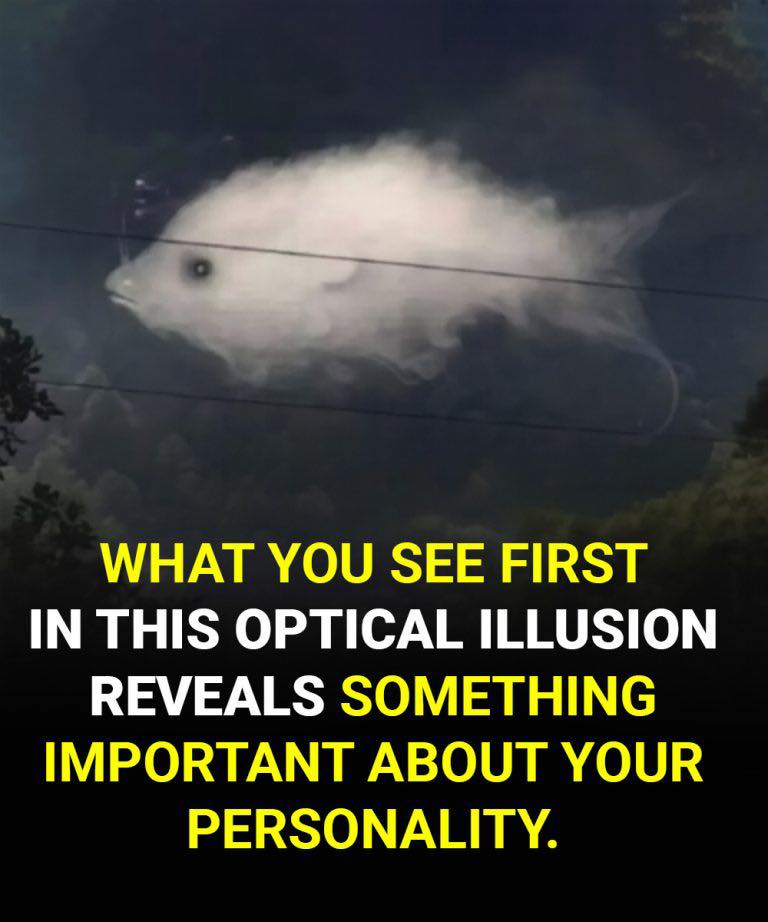Optical illusions are far more than just visual entertainment; they are gateways into the intricate workings of our minds. These illusions, while playful on the surface, offer a unique glimpse into our unconscious thought patterns, underlying emotions, and distinctive ways of interpreting the world around us. The way we perceive an image at first glance can reveal aspects of our personality, current emotional state, and even how we process everyday experiences.
A viral visual test that has taken social media by storm invites viewers to uncover what their initial impression says about them. The question is deceptively simple: Do you see a cloud or a fish first? Yet the implications of your answer may be deeper than you ever imagined.
Do you see a cloud or a fish?
This image has captured the fascination of millions because it illustrates a remarkable truth: everyone looks at the same picture, but not everyone sees the same thing. Some notice a soft, drifting cloud hovering above, while others immediately recognize the silhouette of a fish gliding gracefully through water. The real intrigue lies not in the image itself, but in what your perception reveals about your inner world—how you think, feel, and react to the experiences life presents to you.
The concept of this optical illusion is inspired by studies of visual perception and was popularized by artist and designer Mia Yilin. She highlighted that what you see first is more than a fun visual trick; it acts as a symbolic reflection of your mind’s current state, shaped by your dominant emotions and subconscious priorities.
If you saw a cloud first
Seeing a cloud indicates that you are a reflective, emotional, and imaginative individual. You approach life thoughtfully, often seeking deeper meaning in both grand and mundane experiences. Your sensitivity allows you to empathize with others easily, understanding feelings even without spoken words. Creativity and imagination are your natural allies, guiding you to explore perspectives that others might overlook.
Your strength: Empathy. You instinctively understand the emotions of those around you, offering comfort and insight without needing much explanation.
Your challenge: You may sometimes dwell in nostalgia or idealization, losing yourself in “what could have been” or “what might be” scenarios.
Tip: Balance your emotional insights with concrete actions. Dreams and reflections are valuable, but transforming them into tangible steps will enrich your life and give you a profound sense of accomplishment.
If you saw a fish first
Seeing a fish suggests that you are grounded, practical, and adaptable. You excel in navigating changing circumstances and have a talent for assessing situations calmly and logically. In moments of pressure, you remain composed, making you a reliable anchor for those around you. Your practical approach allows you to solve problems efficiently, often without losing focus.
Your strength: Logic and serenity. You approach challenges with a clear mind and do not act impulsively, making rational decisions even in chaos.
Your challenge: You may sometimes appear distant or emotionally detached, even when you care deeply about what is happening around you.
Tip: Sharing your emotions is a strength, not a weakness. Opening up can deepen your connections and help others understand and relate to you on a more meaningful level.
Why do you see what you see?
Our brains do not analyze an entire image all at once. Instead, they gravitate toward elements that resonate with our current emotional state or past experiences. People who are more sensitive or introspective often perceive ethereal, symbolic shapes like clouds. Those more grounded in reality may quickly identify tangible, concrete figures like a fish.
In essence, what you notice first does not define who you are, but it does reveal a snapshot of how you are feeling in that moment. Because the human mind is fluid and dynamic, repeating the test under different circumstances or on a different day may lead to a completely different perception, reflecting changes in mood, environment, or focus.
Tips for interpreting optical illusions
Avoid searching for absolute truths. These illusions are tools for reflection and self-awareness, not definitive psychological evaluations.
See the image as a mirror. It is not the figure itself, but the emotions and thoughts it evokes in you that matter. Are you curious, reflective, nostalgic, or amused?
Pause and observe. Like life itself, perception depends on your willingness to notice subtleties and observe calmly rather than rush to conclusions.
Embrace change. If you see a cloud today and a fish tomorrow, it is not inconsistency—it is a sign of emotional growth, adaptability, and the evolving nature of your inner world.
Every visual perception tells a story. It can hint at your fears, desires, priorities, and the ways in which you interact with the world. These tests are not designed to label or confine you but to invite introspection and self-understanding. Ultimately, the images we perceive reflect something about our inner landscape. What you see outside often mirrors what is present within. By paying attention to these reflections, you gain insight into your emotional patterns, thought processes, and personal journey through life.
